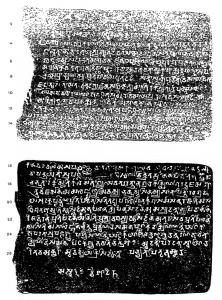
Seal.
[The seal] of the government of a district in the province of Vâraka.
Plate.
Om! Welfare! During the sovereignty of the supreme king of great kings, Srî-Dharmaditya, which sovereignty is without an adversary on this earth and is equal in steadfastness to Yayâti and Ambarîṣa—in the time of the reigning of the great king Sthâṇudatta, who gained his dignity through his (DharmâJitya’s) favour—in the province of Vâraka which was entrusted to him (Sthâṇudatta), Jajâva as lord of the district has the direction and administration. The leading men of the district, who were headed by Itita, Kulacandra, Garuḍa, Vṛhaccaṭṭa, Âluka, Anâcâra, Bhâśatiya, Subhadeva, Ghoṣacandra, Anamitra, Guṇacandra, Kâlasakha, Kulasvâmin, Durlabha, Satyacandra, Arjuna-bappa and Kuṇḍalipta, and the common folk were apprised by the agent Vâtabhoga, thus:—“I wish to buy a parcel of cultivated land from your honours and to bestow it on a brahman; therefore do ye deign to take the price from me, to divide the land in the district and to give it to me.”
Wherefore we, giving heed to this request and being unanimous, determined the matter by a determination by the keeper of the records Vi[na]yasena. There is in this district the rule established along the eastern sea that cultivated lands are things which are sold according to the rate of the sum of four dînâras for the area that can be sown with a kulya of seed, and that the evidence of a sale is by the custom of giving a copper-plate, which custom applies immediately on seeing the counting made for the parcel of cultivated lands of such-ans-such-sowing area; and then the feet of the Emperor receive the sixth part of the price according to the law here. Therefore the agent Vâtabhoga, having adopted this procedure, and having by tendering the deposit [compiled with it] by the act as well as by the intentions of one who has desired to establish the fame of his own merit, and having paid twelve dînâras in our presence—we, having severed the land according to the standard measure of eight reeds in breadth and ninde in length by the hand of Sivacandra, have sold to Vâtabhoga a triple kulya-sowing area of cultivated land in Dhruvilâtî by the custom of the copper-plate.
This very Vâtabhoga, who desires benefit in another world as long as this land shall be enjoyed while the moon, the stars and the sun endure, has joyfully, for the benefit of his own parents, bestowed the land on Candrasvâmin, who is of the lineage of Bharadvâja, who is a Vâjasaneya and who studies the six Angas. Therefore the kings, who are neighbours to the above-mentioned grant and who have studied the scriptures, fully understanding that “gifts, although given absolutely to persons who rejoice in safeguarding or in discarding gifts of land, must be held valid by these kings,” must scrupulously safeguard this gift of land.
And the boundary-indications are here stated: on the east, Himasena’s portion of the village; on the south, the three ghâṭs and the land of the other copper-plate; on the west, the paths to the three ghâṭs and the Sîlakuṇḍa; on the north, the ship-building harbour and Himasena’s portion of the village.
And here applies the verse: Whoever confiscates land that has been granted away by himself or granted away by another, he becoming a worm in a dog’s ordure rots along with his ancestors.
In the regnal year 3; the fifth day of Vaisâkha.